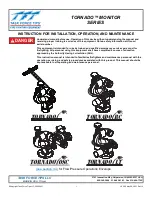
.
PILOT LAMP
The pilot lamp facilitates orientation at night and enables you to see objects on the display
of a digital camera. The pilot lamp is switched on by turning the rotary switch to “PILOT1”
or “PILOT2”.
Switch Position
Dimmer function
Power
L1
50%
L2
100%
SOS FUNCTION
In emergency situations, e.g. on a drifting boat, or when you lose contact with a companion
under water, in twilight conditions or at night, it is practical if you can attract the attention of
people trying to help you. If you turn the switch to
SOS
, the flash gun flashes approx. 12
times per minute at ¼ of its normal performance. Depending upon the residual capacity of
the accumulator, this means that the flash gun will continue to operate at its lowest power
output level for up to 8 hours.
Fully automatic TTL flash operation (analog)
TTL FLASH OPERATION with analog cameras (center socket)
In TTL mode, the flash gun recognizes the connected camera
automatically
. You just
need to set the selector switch to “TTL”.
The meter cell, which is located inside the camera, measures the light reflected from the
film plane. The camera electronics evaluate this reading and send a cut-off signal to the
flash gun
.
•
The camera is therefore responsible for the correct exposure as it controls the
emitted luminous intensity. This means that the exposure can only be
manipulated in this mode by adjusting the camera.
ERROR indicator:
If the emitted luminous intensity is insufficient, i.e. if the flash gun is operating at
full power in TTL mode, the ERROR LED lights up for approx. 3 seconds and the
“flash ready” LED blinks simultaneously. If this happens, increase the aperture by
one or two settings.
As soon as the flash gun has been attached to a camera and it is ready for use, the flash
symbol in the viewfinder lights up when you gently press the shutter button. If this does
not happen, please verify whether the ready lamp on the flash gun is functioning
correctly. If it is, check whether the plug connectors are clean and connected properly.
Extremely reflective objects and taking photographs against the light invariably result in
underexposure when using the flash gun in TTL mode. In such situations, you should
preferably use the flash gun in manual mode or change the film speed setting on the
camera to a positive setting (+). Do not forget to reset the film speed afterwards.
The TTL automatic mode is also not able to cope with extremely wide-angle lenses when
taking photographs of relatively small objects against a dark background. The meter cell
mainly takes a reading from the dark background and switches the flash gun off too late.
This results in overexposure.
Page 6 of 20
Summary of Contents for Nova
Page 1: ...03 2010 ...
Page 18: ... Notes Page 18 of 20 ...






































